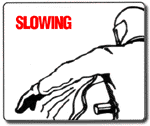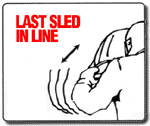







CCSO Approved Hand Signals
LEARN THE PROPER HAND SIGNALS
Left Turn
left arm extended straight out from shoulder and pointing in the direction of the turn
Right Turn
left arm raised at shoulder height, elbow bent and forearm vertical with palm of hand flat
Stop
left arm raised from the shoulder and extended straight up over the head with palm of hand flat.
Slowing
left arm extended out and down from the side of body with a downward motion of hand to signal warning or caution
Oncoming Sleds
Left arm raised at shoulder height, elbow bent and forearm vertical, wrist bent, move arm left to right over head pointing to right side of trail.
Sleds Following
Arm raised, elbow bent, with thumb pointing backward, in hitch-hiking motion move arm forward to backward over your shoulder.
Occasional you may see oncoming riders indicate the number of sleds left.
Last Sled in Line
Release handlebar with left hand, palm of hand flat, slash forearm outward at a 45º downward angle toward the ground repeatedly.
Another couple, although though they are not CCSO:
"Thumbs up" - this can be a question or an answer. Usually the lead will show thumbs up, asking the group if they are ready to ride. Your response if you are ready is a thumb up. If someone thinks you are having a problem they may ask you for a thumbs up the same way.
"Debris or Hazard" - most people point at debris or hazards when they see them for the benefit of other sleders. This can be confused with the "slowing signal", but that's not a bad thing.
Generally hand signals are carried backward throughout the sled line. It's your responsibility to pass messages back like "hazzard", "stop" and "on-coming". And for on-coming traffic "sleds following" is especially important if you have a gap behind you.

